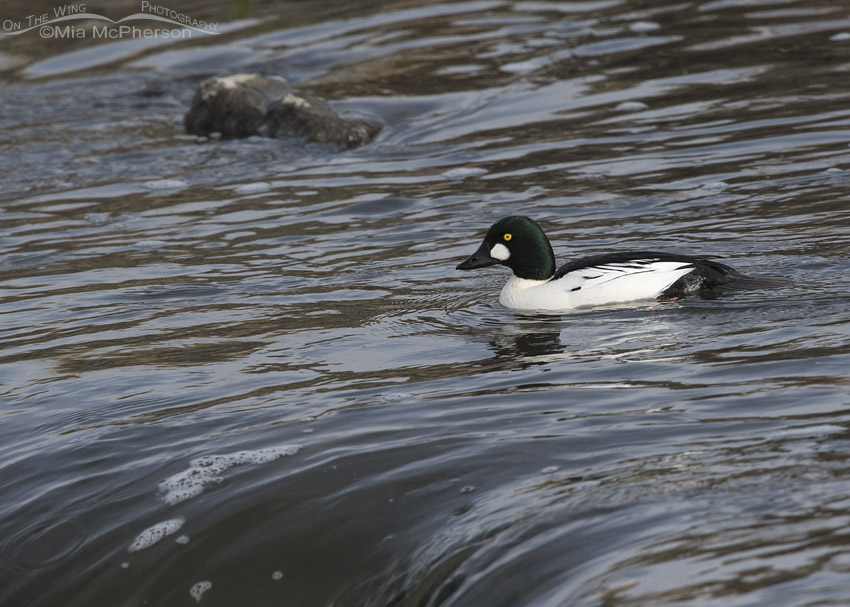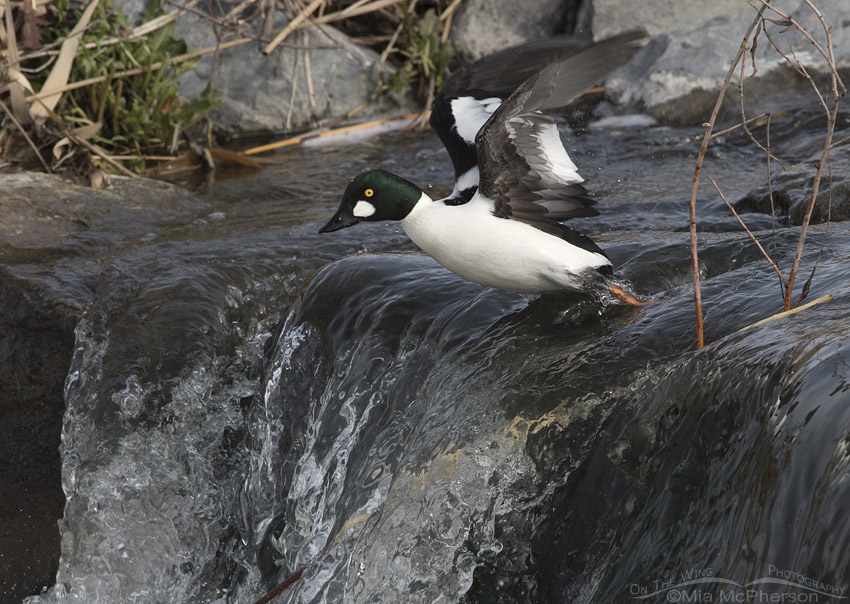 Drake Common Goldeneye on the Jordan River – Nikon D500, tripod mounted, f7.1, 1/1600, ISO 500, -0.7 EV, Nikkor 500mm VR with 1.4x TC, natural light
Drake Common Goldeneye on the Jordan River – Nikon D500, tripod mounted, f7.1, 1/1600, ISO 500, -0.7 EV, Nikkor 500mm VR with 1.4x TC, natural light
A few days ago I photographed this male Common Goldeneye in breeding plumage on the Jordan River in Salt Lake County, Utah in low light on a cold morning. Early on the light was poor as the drake goldeneye preened, bathed and dove under the water searching for food.
After a bit the goldeneye floated down the river so I moved down with him and set up my tripod on the bluff overlooking the water below. As he got closer and closer to the small run of rapids I hoped to capture images of him as he went over them and I also hoped the light would get better, it was only slightly better when when I took these two images of the goldeneye.
 Male Common Goldeneye taking off from the top of some rapids – Nikon D500, tripod mounted, f7.1, 1/1250, ISO 500, -0.7 EV, Nikkor 500mm VR with 1.4x TC, natural light
Male Common Goldeneye taking off from the top of some rapids – Nikon D500, tripod mounted, f7.1, 1/1250, ISO 500, -0.7 EV, Nikkor 500mm VR with 1.4x TC, natural light
I was only able to capture this one sharp image of the Common Goldeneye drake as he took off from the top of the rapids but I was pleased with it because the water was frozen in motion and I only had a tiny bit of motion blur in his wings.
The Jordan River of northern Utah flows for about 51 miles through Utah and Salt Lake Counties. It is named after the Jordan River that flows through the “Holy Lands” of Jordan, Israel and the State of Palestine. The Jordan River here flows north from Utah County to Salt Lake County and it empties into the southern part of the Great Salt Lake.
Prior to the arrival of the Mormon Pioneers the Jordan River was home to 13 native species of fish and large mammals including bighorn sheep, wolves, mule deer, beaver and coyotes.
Today the large animals that are found there are raccoons, red foxes, some coyotes and domestic pets. Many of the native fish are also gone.
The Jordan River provides important habitat for over 200 species of birds that live or breed along it or use it as a stop-over during their migrations.
I’m glad I live so close to the Jordan River because during the winter if a sucker hole opens in the clouds I can be there in minutes to photograph birds. That is what happened the day I photographed this drake Common Goldeneye.
Life is good.
Mia
Click here to see more of my Common Goldeneye photos plus facts and information about this species.


Thank you for your comments, I much appreciate them.
Great shots Mia. Love the water. It is so vivid you can almost hear it rushing over the rocks. But I have to plead a little ignorance here…why is a break in the clouds called a “sucker hole”? Thanks.
Hi Pepe, we call them sucker holes because they sucker us into believing the weather is changing for good but they are usually short-lived breaks in the weather. But for me even a short break that provides light can be a good thing. I did this screen shot of the clouds this morning where is shows two sucker holes in the clouds southeast of where I live.
What a charmer. Thank you.
Gorgeous images in the soft light. I also enjoyed learning more about the Jordan River. Quite the rainfall yesterday and again today. Just hope the snow holds off until tonight.
The bird is beautiful in both images and so is the water…the colors and the patterns…
Beautiful images, Mia.